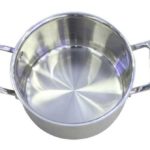Stainless steel products are commonplace in consumers’ lives. However, not many people know that stainless steel, or inox, comes in various types, each with its own unique properties. If you have, are currently, or plan to use products made of 304 stainless steel, then you’re in the right place! Read on to learn about the unique characteristics of this material.
1 What is 304 Stainless Steel?
 What is 304 Stainless Steel?
What is 304 Stainless Steel?
304 stainless steel is an alloy created by combining steel with familiar metals such as nickel and chromium, with a minimum of 8% nickel content. It is considered the most common stainless steel alloy in the world today.
304 stainless steel is used in the manufacturing of household products and kitchen utensils. Its distinctive properties include resistance to oxidation and corrosion, low susceptibility to color change due to environmental factors, and high durability.
2 How to Distinguish Different Types of Stainless Steel
 Distinguishing Different Types of Stainless Steel
Distinguishing Different Types of Stainless Steel
To differentiate 304 stainless steel from other common alloys on the market, you can use the following methods:
- Magnet Test: 304 stainless steel exhibits fairly strong magnetic properties. During the product formation process, the application of high pressure at room temperature can cause the material to transform into a Martensite structure, resulting in magnetic properties.
- Acid Test or Specialized Testing Solutions: Products made of 304 stainless steel do not react when exposed to acids; other alloys, such as 201 stainless steel, will produce a bubbling reaction. When using specialized testing solutions, 304 stainless steel turns gray, while 201 stainless steel turns brick red.
We hope this article has helped you understand more about 304 stainless steel and how to identify products made from this material. Don’t forget to follow us for more useful information and updates!































